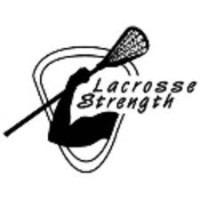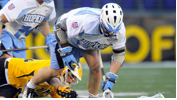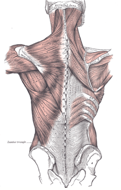
-April 23rd, 2012-
In Lacrosse, the shoulder doesn’t get much attention. In Baseball, Volleyball, or Swimming, its what most coaches think about. But that doesn’t mean we should neglect it in Lacrosse, either. There are shoulder injuries in lacrosse. Some we can try to reduce and others we can’t. First we’ll run through the different types of shoulder injuries that could be seen. Then, discuss different methods for reducing the incidence of those injuries. Finally, we’ll go over different methods of training to help keep the shoulder complex as strong as possible.
Shoulder injuries can be broken down into direct injuries or indirect injuries. Direct shoulder injuries would be a fractured clavicle, or a contusion to the deltoid. Shoulder separations, or Acromioclavicular joint sprains occur when an athlete falls directly on the tip of the shoulder, separating the Acromion Process of the shoulder from the clavicle. Indirect injuries are more common. They would consist of shoulder subluxations or dislocations. They usually occur when the athlete falls on an outstretched hand or elbow. The resulting forces from the fall travel up the arm to the shoulder, where the joint is compromised. Additionally, I’ve seen shoulder strains, usually defensemen, as they try to get under the stick of the opposing player and lift. The force of lifting the stick of the opponent is exponentially greater because the force is applied at the end of a long pole. Applying this force overtime could lead to a strain to the rotator cuff, or tendinitis to the massive rotator cuff tendon, which encapsulates the glenohumeral head.
In order to reduce the incidence of shoulder injuries, we need to look at the important structures around the shoulder and how they are supposed to interconnect. By looking at Mike Boyle’s joint-by-joint paradigm, we see the lumbar spine should be a stable segment, the thoracic spine should be mobile, the scapulothoracic junction should be stable, and the glenohumeral joint mobile. By this model we should be looking for exercises that will help create the appropriate outcome.
More specifically, let’s take a look at the role of the scapula. It’s common to forget the glenohumeral joint is connected to the scapula. The glenoid fossa is part of the scapula. This is important when following the ground forces up through the chain, through the shoulder and out the hand. Anywhere along the chain, energy can be leaked out, which will decrease the forces available down the chain. In our case of the shoulder, if the scapula is not strong and stable, energy will be leaked out and the muscles surrounding the glenohumeral joint will take on more work than they are built to handle. This can turn into mild strains or tendonitis.
Additionally, we should look at the importance of the thoracolumbar fascia.
As Patrick Ward points out, “considering the latissimus dorsi has attachments onto the thoracolumbar fascia and inserts onto the lesser tubercle of the humerus, the glenohumeral joint can also be thought of as ‘connected’ with the thoracolumbar fascia.” This network of muscle and fascia provides stability throughout the region. For this reason, the thoracolumbar fascia needs to be free of restrictions and adhesions.
Before any training is done, a bout of Self Myofascial Release can help with increasing blood flow to the area and reducing muscle and fascial tightness. For the shoulder, three areas are the focus of treatment: Thoracic Spine, Pec Minor, & Lats. After SMR, some activation-type exercise can be accomplished, such as Wall Stick ups, YTLW’s, Push up Plus, and Hand Replacements. These exercises help to ready the scapula and rotator cuff for heavier loads in the base part of the workout.
Pete Koeniges, M. Ed., ATC, YFS owns Athletic Training Consultants, LLC and is the Athletic Trainer for Northern Highlands Regional High School in Allendale, NJ and is the former ATC for the New Jersey Pride of Major League Lacrosse. http://www.LacrosseStrength.com
Tags: Assessment, corrective exercise, injury prevention, Notre Dame Lacrosse Strength and Conditioning, pete koeniges, Shoulder, wall angels, wall slides




Leave A Reply (3 comments so far)
Sean Holmes
13 years ago
Thanks Pete for the Awesome Information.
Best Realtor Near
5 years ago
Hong Kong Land is truly an amazing property developer.
And they already started constructing their buildings in Mandaue City.
House Music
4 years ago
Best #residential #realestate #property #project
near #infosys #Indore..